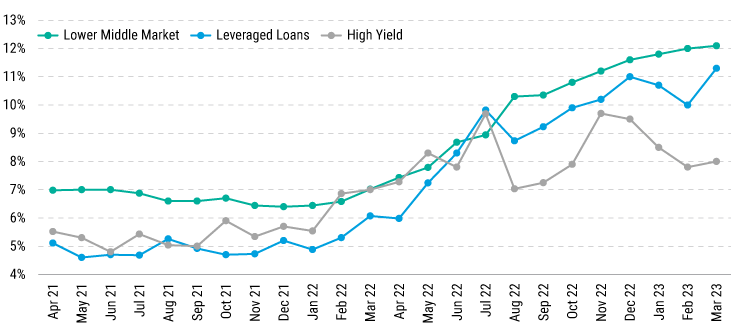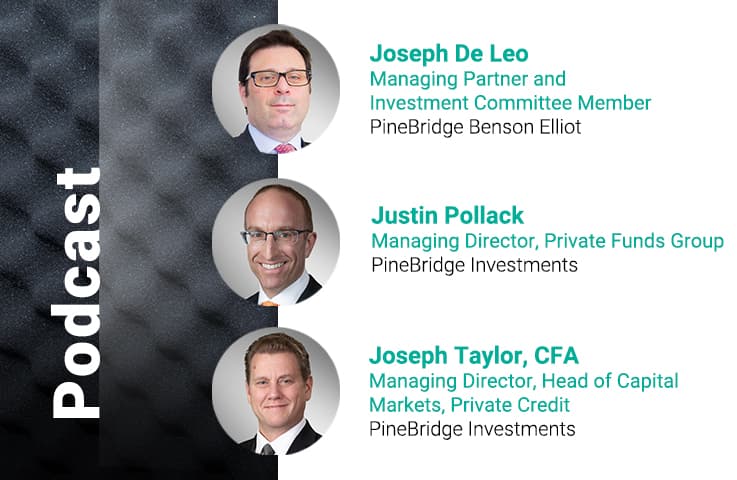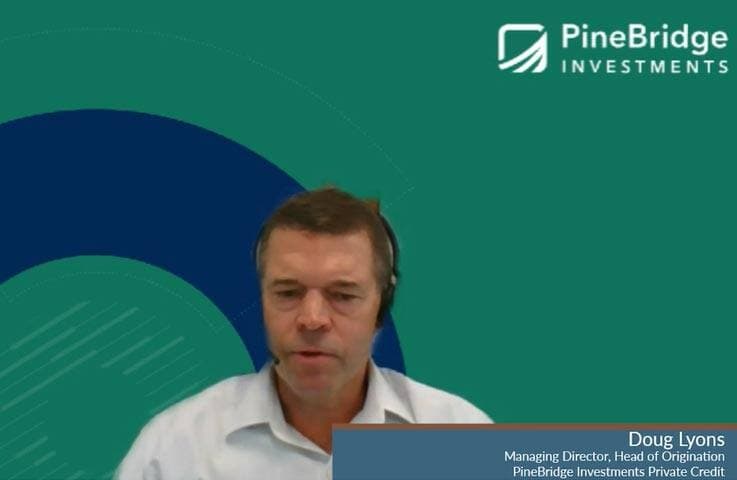2023 Midyear Private Credit Direct Lending Outlook: Durability to Weather Challenges

James Fisher
Head of Private Capital

Brian Senatore
Managing Director, Head of Portfolio Management & Underwriting

Doug Lyons
Managing Director, Head of Origination

Joseph Taylor, CFA
Managing Director, Head of Capital Markets

Private credit direct lending has demonstrated its durability through multiple cycles and under stressful macro conditions, and many investors have historically considered private credit direct lending to be a critical part of their diversified fixed income portfolios, aiming to provide attractive yields and safety.
Historically, lower-middle-market companies (with EBITDA of $7.5 million to $30 million) that have long operating histories, leadership positions in their market segments, and seasoned management teams at the helm have shown to be compelling investments.
While new deal M&A is expected to remain somewhat soft for the rest of 2023, the depth of the direct lending market combined with potential add-on investment activity are some of the factors that demonstrate that the middle-market segment remains open and positive for private lenders.
In light of current macro challenges, we believe it is critical for private credit investors to look under the hood at an investment’s “cushion” – namely, fixed-charge and interest coverage, variable versus fixed costs, and leverage ratios.
The historically durable “all weather” attributes of private credit direct lending, which has successfully weathered challenging macro periods in the past, have come to the fore in the current high-interest-rate environment. While merger and acquisition (M&A) activity is likely to cool somewhat, private equity sponsors appear to be pivoting toward lending opportunities with existing portfolio companies in support of growth. Overall, we believe the opportunity set for investors remains robust and deep enough to enable a selective approach, including both new and add-on lending opportunities. We view experience as a critical differentiator in the current environment, along with highly disciplined credit and sector selection and strong partnerships with private equity sponsors.
Investors employing an approach that focuses on safety, selectivity, and market leadership are believed to drive stable performance through challenging market conditions, and over time. With current yields of roughly 12% in lower-middle-market direct lending1 and a more lender-friendly environment (with better pricing and tighter terms), sophisticated investors see the asset class as well positioned for the rest of the year and continues to offer attractive risk-adjusted return potential.
Key Convictions
1) Lower-middle-market companies with long operating histories, leadership positions in their market segments, and seasoned management teams at the helm remain compelling investments.
While private credit is not one-size-fits-all and provides many different “flavors,” PineBridge has historically focused on traditional lower-middle-market direct lending – with conservative structures, traditional sectors, and investing alongside experienced private equity sponsors. Historically, lower-middle-market companies (with EBITDA of $7.5 million to $30 million) that have long operating histories, leadership positions in their market segments, and seasoned management teams at the helm have shown to be compelling investments.
Businesses that have shown stability and durability during both stronger and weaker environments and that benefited from real cash generation and a competitive “moat” – i.e., distinct relevance and value to their client base – have been viewed as stable, quality opportunities.
When paired with a conservative approach to portfolio construction and underwriting, investors who target these types of opportunities have historically stood to garner durable risk-adjusted return potential across macroeconomic environments.
Sector selection also matters – and those service-oriented business models have tended to perform better in a high-inflation environment (less sensitive to inflation relative to manufacturing companies). Broadly speaking, the companies with the strongest prospects appear to be those with long operating histories (measured in decades, not years) that display leadership in their market segments, with seasoned management teams and leading private equity sponsors at the helm.
2) M&A is likely to weaken, but lending opportunities are still plentiful.
A weaker macroeconomic backdrop and the resulting hit to earnings is likely to curb M&A in the second half of 2023. PE sponsors are expected to have longer holding periods for their investments and be slower to sell their portfolio companies as they try to avoid selling into an environment in which lower earnings mean companies command lower valuations in the market.
Similarly, valuations for first-time buyouts – where the founder/owner/management is selling to a PE sponsor – may contract as management teams hold off on selling majority control in an environment where earnings are challenged.
Given these dynamics, valuations for quality businesses will likely remain high given the slower M&A environment, with fewer high-performing companies coupled with high demand for quality assets.
Despite a somewhat weaker M&A environment, lending opportunities to companies in the lower-middle-market segment appear to remain open and positive for private lenders – especially when including add-on volume as sponsors pivot to opportunities with existing portfolio companies. Approximately $120 billion of core and lower-middle-market loan volume closed in the last 12 months alone (as of 31 March 2023),2 a level of deployment that denotes a deep opportunity set. Further, when considering the level of private equity fund dry powder, combined with debt maturities coming due for existing middle-market loans, the financeable opportunity set in the next five years appears to represent approximately $200 billion of new loan demand in the lower-middle-market segment.
This level of depth enables a selective approach with high standards for quality that seeks to deploy a small fraction of the total volume on an annual basis.
3) In light of current macro challenges, private credit investors must look under the hood at a portfolio’s “cushion” – namely, fixed-charge and interest coverage, variable versus fixed costs, and leverage ratios.
Liquidity and transparency remain top of mind for investors, with a focus on companies’ earnings and cash flow, and three key aspects of an investment’s “cushion” are considered by many to be critical.
First, fixed charge and interest coverage ratios largely determine whether a company can cover its debt service – in addition to capex, working capital, and other operating expenses – if conditions become more challenging. We view an interest coverage ratio at or above 2x and a fixed-charge ratio of at least 1.25x as healthy and providing the flexibility needed to weather a downturn.
Second, variable cost structures, which can be flexed as needed to preserve margins and free cash flow, can be a positive relative to high-fixed-cost businesses in today’s environment, when inflation and remaining supply constraints may make it difficult to cut costs.
And third, investments with robust equity cushions and moderate levels of leverage are expected to fare better. In transactions with a more significant equity investment, the sponsor is more readily inclined to focus on supporting that investment with additional equity capital. Moreover, the higher the leverage, the greater the interest rate sensitivity. While private credit direct lending typically benefits from a “higher” rate environment (as a floating-rate strategy based on a spread over a base rate), excessive leverage can compress earnings and strain liquidity. We believe the asset class is well positioned in the current rate environment, assuming no further significant increases.
Rate Hikes and Spread Increases Have Pushed Lower-Middle-Market Yields Over 12%

Source: KBRA DLD Private Data; 90-day rolling averages; BSL, 2L, and HY: Pitchbook LCD, which uses a blended Libor/SOFR rate provided by IHS Markit; 2L—not enough observations for averages since January; CME Group’s 3M Term SOFR is the reference rate used for DLD yields beginning in January 2022. Lower middle market: <= $20 million. Data as of 31 March 2023.
For more of our views on what’s in store for investors and markets in the second half, see our 2023 Midyear Investment Outlook.
Foonotes
1 Source: KBRA Direct Lending Deals. March Q1 2023 Insights & Outlook U.S. Sponsored Deals. Represents yield for lower-middle-market deals, defined as those companies with less than $20.0 million in EBITDA. 2 Source: Refinitiv LPC’s 1Q’23 Middle Market Sponsored Private Deal Analysis. As of April 2023.
Disclosure
Investing involves risk, including possible loss of principal. The information presented herein is for illustrative purposes only and should not be considered reflective of any particular security, strategy, or investment product. It represents a general assessment of the markets at a specific time and is not a guarantee of future performance results or market movement. This material does not constitute investment, financial, legal, tax, or other advice; investment research or a product of any research department; an offer to sell, or the solicitation of an offer to purchase any security or interest in a fund; or a recommendation for any investment product or strategy. PineBridge Investments is not soliciting or recommending any action based on information in this document. Any opinions, projections, or forward-looking statements expressed herein are solely those of the author, may differ from the views or opinions expressed by other areas of PineBridge Investments, and are only for general informational purposes as of the date indicated. Views may be based on third-party data that has not been independently verified. PineBridge Investments does not approve of or endorse any republication of this material. You are solely responsible for deciding whether any investment product or strategy is appropriate for you based upon your investment goals, financial situation and tolerance for risk.




